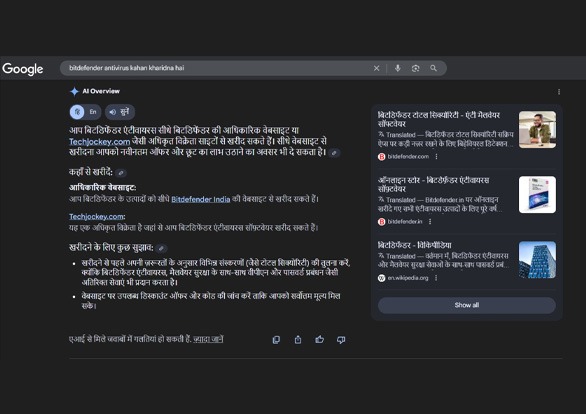How AI and Techjockey Are Powering the Rise of Vernacular Software Discovery in India
By Impact Desk | Updated: November 28, 2025 15:14 IST2025-11-28T15:13:17+5:302025-11-28T15:14:26+5:30
As Artificial Intelligence continues its march across industries, its most profound impact on digital discovery is not in India’s ...

How AI and Techjockey Are Powering the Rise of Vernacular Software Discovery in India
As Artificial Intelligence continues its march across industries, its most profound impact on digital discovery is not in India’s metropolises, but in its vibrant Tier 2 and Tier 3 cities. Here, the synergy of AI-powered search and the surge of regional language usage is reshaping how software is discovered, evaluated, and adopted.
India is poised for a digital leap. According to DataReportal (2025), the nation has over 806 million internet users, representing more than 55% population penetration, and is projected to cross 900 million by the end of 2025, with the majority emerging from non-metro regions. These new users bring fresh expectations: content in their native tongues, tools tailored to their realities, and buying journeys that feel human, even in digital spaces.
Beyond Translation: AI’s Role in Contextual Understanding
Voice assistants, generative search engines, and chatbots have transformed discovery. These tools increasingly understand not only Hindi or Tamil, but also the nuanced phrasing of intent in smaller cities like Bhopal or Madurai. Google has observed a 270% surge in voice searches in Indian languages over the last three years, peaking during business hours in regional belts.
“With AI interpreting search more like human conversation, brands must rethink their strategy to reflect how users actually speak, not just what they search,” says Ratnakar Patrayudu, Sr. Manager - Organic Growth & Search Strategy at Techjockey. “You’re not just optimising for a word - you’re optimising for how a shop owner in Vishakapatnam asks a question in Telugu.”
This is a critical shift: brands must move beyond generic keywords to natural, vernacular queries. Content must be technically structured for AI parsing yet contextually rich and emotionally resonant for real users.
From Keywords to Context
Traditionally, discovery started with broad searches like “best CRM in India.” But in Tier 2 and 3 cities, queries are now intent-rich and conversational:
For example, traditional queries like “best CRM in India” are being replaced by natural, intent-driven phrases such as:
- “Mere dukan ke liye simple billing software kaunsa hai?” (What is a simple billing software for my shop?)
- “पोल्ट्री फार्म के लिए आसान अकाउंटिंग सॉफ्टवेयर कौन सा है?” (Which accounting software is easy for a poultry farm?)
These queries often blend voice input and hybrid dialects. They demand more than translation, they require genuine regional adaptation that reflects local decision-making psychology. English-only product pages risk invisibility in this fast-growing market.
Techjockey’s analysis echoes this gap: millions of businesses in Tier 2 and 3 cities are actively searching for software in Hindi, Tamil, Telugu, or Marathi but are often met with content that feels foreign or overly technical.
In an AI-powered ecosystem, not being discoverable in local languages doesn’t just mean missed leads; it means digital invisibility.
Bridging the Discovery Gap: The Unmet Demand
Despite this clear demand, a 2024 SEMrush India study reveals a significant disconnect:
- Only 6% of software vendors have regional-language optimised pages.
- Fewer than 3% offer localised demos or explainers.
- Over 80% of content is still created with metro-centric buyers in mind.
This creates a massive discovery gap, particularly for Small and Medium Businesses (SMBs) in Tier 2 and 3 cities eager to digitise. In an AI-powered search environment, being invisible effectively equates to irrelevance.
Assisted Discovery: The New Expectation
Reports highlight a strong preference for guided buying experiences among Indian SMBs. A NASSCOM and Zinnov report (2024) indicates that:
- 68% of SMBs prefer assisted buying over self-service platforms.
- 93% of Indian SMEs desire software discovery content in Hindi or other local languages.
- 72% assert that side-by-side comparisons and peer reviews bolster their purchase confidence.
This is where curated software marketplaces, such as Techjockey, become vital. They bridge the discovery gap with guided filters, software comparisons, and advisory-led content in multiple languages.
“In Tier 2 and Tier 3 markets, more than 70% of discovery journeys now start with vernacular queries, most of them voice-based. Our role as a marketplace goes beyond listing tools; it’s about guiding users through a buying experience that feels natural in their own language,” says Rajesh Patidar, Product Head at Techjockey. “With side-by-side comparisons, multi-language walk-throughs, and AI-powered recommendations, we make sure a shopkeeper in Indore or a poultry farmer in Salem quickly finds exactly what they need.”
Instead of overwhelming users with dozens of vendor websites, AI-assisted marketplaces personalise discovery by factoring in industry, company size, integration needs, and even regional context.
From Search to : The Future of Vernacular Software Discovery
For Techjockey, the mandate is clear: optimise for human values. The next wave of buyers may come from Kochi, Bhilai, Salem, and Guwahati, speaking Bhojpuri, Oriya, Kannada, Telugu, and Marwari. They expect software to be not only functional but discoverable and trustworthy in their cultural and linguistic context.
The future of software buying in India will be powered by AI, but guided by Techjockey.com.
Open in app